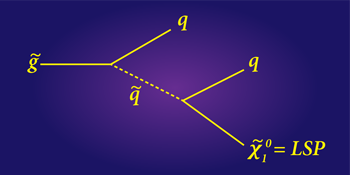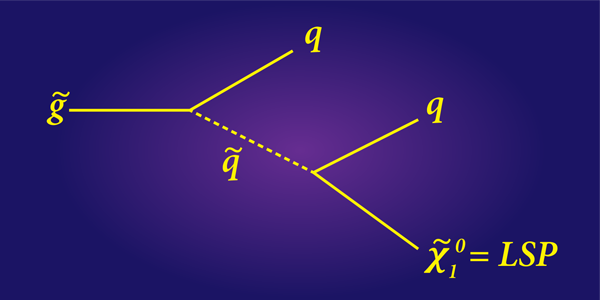Still Waiting for Supersymmetry
A paper appearing in Physical Review Letters announces the latest—and most extensive—search for evidence that a candidate theory, called supersymmetry, which explains dark matter and unifies three of the fundamental forces, is correct [1]. As reported by the CMS collaboration at CERN’s Large Hadron Collider (LHC), no particles predicted by supersymmetry have been found, suggesting that the theory is likely more complicated than many had hoped.
The standard model of particle physics describes the elementary particles (the smallest building blocks of our world) and the forces that act between them: the electromagnetic force, the strong force (that holds together the atomic nucleus), and the weak force that is responsible for certain forms of radioactive decay. The matter building blocks contain the quarks (the particles that make up protons and neutrons) and leptons, which include the electron.
The standard model is the most precise and successful theory ever developed—in some cases, theory and experiment agree out to ten significant digits. The only missing building block of the model is the famous—and, so far, elusive—Higgs particle, which is needed to give mass to all other elementary particles.
Despite its success, most physicists are convinced that the standard model cannot be the ultimate theory. The most apparent problem with the model is that it cannot explain dark matter. Over the last ten years, several experiments established independently that the visible matter (from which humans, the earth, the solar system, and all galaxies are made of) constitute only a small fraction of all matter in the universe. What constitutes the remaining, missing matter—the dark matter—remains one of the great mysteries of modern physics.
Theoreticians have proposed a number of extensions of the standard model. The most studied of these is the so-called minimal supersymmetric standard model (MSSM). In slightly simplified terms it requires that all standard model particles are accompanied by a supersymmetric partner particle, which has a spin differing by half a unit. As an example, if the MSSM is the correct description of nature, the electron with spin = 1/2 has a partner particle with spin = 0. The lightest of these supersymmetric partner particles, which is most probably the supersymmetric partner of the photon, constitutes a perfect candidate for dark matter. It yields the correct amount of dark matter in the universe as measured in astrophysical experiments. This particle is aptly called the LSP (lightest supersymmetric particle). It hardly interacts with normal matter; in fact, it can pass through the earth without hitting a single atom or deviating from its path. No supersymmetric partner particles have been observed in particle accelerator experiments. Assuming they do exist, this means they are too heavy to be produced with the energy available at existing accelerators.
Another interesting feature of the MSSM is the following: although the standard model describes three forces of nature, it is only within the MSSM that these three forces can easily be unified into a single force. This happens naturally in the MSSM at very high energy scales, at about 2×1016 times the mass of the proton—the so-called grand unification (or GUT) scale.
Assuming that, at these high energies, the forces are unified and the masses of the supersymmetric particles are unified (that is, they are equal) as well, much simpler versions of the MSSM can be constructed. One of them is the constrained MSSM (or CMSSM), but many others exist [2]. Even if we find that the MSSM is realized in nature, we still have to investigate which of the supersymmetric GUT scale models might be realized.
One of the main tasks of the LHC is to sort through the products of high-energy collisions in search of the new particles predicted by MSSM. The LHC, which began running experiments in 2010, consists of a 27-kilometer-long ring, located about 100 meters underground. Two beams of protons circulate within the ring, one clockwise, one counterclockwise. At each of the four points where the two beams are forced to collide, detectors record what happens in these energetic mash-ups. These four detectors are called ATLAS, CMS, LHCb, and ALICE.
The ATLAS collaboration reported one of the first searches for supersymmetry particles in early 2011 [3]. The new report from CMS [1] describes the most recent search for supersymmetric particles in proton-proton collisions recorded up until the summer of 2011. According to the MSSM, the collision of two protons at sufficiently high energies should produce either two gluinos, the supersymmetric partner of the gluon (the mediator of the strong force in the standard model), or scalar quarks (called squarks), the supersymmetric partners of the quarks. The gluinos or squarks then decay to lighter supersymmetric particles and quarks (see Fig. 1, which shows the decay of a gluino). In the very end, the LSP is produced, which escapes the detector “unseen.” In their analysis of the data [1], CMS searched for the production of many quarks at the same time, together with “unseen” or “missing” energy that is carried away by the LSP, one of the classic signatures of supersymmetric theories, especially of the CMSSM. However, no such signatures (beyond what is already predicted by the standard model) have been seen by the CMS experiment.
It’s important to realize that CMS’s results do not exclude supersymmetric theories. Rather, they only conclusively say one of two things. One possibility is that the CMSSM (the specialized version of the MSSM) is realized in nature, but the supersymmetric partner particles, the gluinos and squarks, are relatively heavy—too heavy to be produced in large numbers at the LHC so far. In other words, their masses may be above a certain limit, set by the current experimental analysis. This limit is shown in Fig. 4 of the CMS paper [1]. The figure shows the plane of two mass parameters in the CMSSM, m0 for spin- 0 particles and m1/2 for spin- 1/2 particles. The red line indicates the experimental limit. All values below this line cannot be realized in nature following the CMS analysis. Gluinos or squarks must be, roughly speaking, heavier than about 1000 times the mass of the proton.
The other interpretation is even simpler: while supersymmetry is realized in nature, it might not take the form described by the CMSSM, but possibly that of any one of the many (GUT scale) models. Different versions of supersymmetry make different predictions for the outcomes of high-energy proton-proton collisions. Many of these outcomes are more complicated than what is shown in Fig. 1, and to see them would require experiments to investigate many more collisions (and to study them for a longer time). Consequently, in these other models, it will only be possible to place much weaker bounds on the new particle masses (so far, however, no such dedicated analysis has been performed).
While supersymmetry remains one of the hot candidates for the very much needed extension of the standard model, physicists may have to accept that it is not realized in its simplest forms. The search for supersymmetric particles at the LHC has just begun. To draw a clearer picture, many more proton-proton collisions will need to be studied. Right now, the field of elementary particle physics is in one of its most exciting phases in history.
References
- S. Chatrchyan et al. (CMS Collaboration), Phys. Rev. Lett. 107, 221804 (2011)
- S. S. AbdusSalam et al., arXiv:1109.3859 (hep-ph)
- G. Aad et al., (ATLAS Collaboration) Phys. Rev. Lett. 106, 131802 (2011); D. Toback, Physics 4, 27 (2011)





